|
Monday, December 10, 2007
Progress Notes
Earlier in one of my previous narratives on this page I discussed several old time
general stores owned and operated by members of the Schell family in Eugene, Mary's Home,
and St. Elizabeth. This week I would like to highlight Hauenstein's General Store in
Tuscumbia. William Hauenstein Sr. an immigrant to this country (photo 01) had returned to Germany in 1871 and on his trip
back to the United States he brought his nephew and niece, George T. Hauenstein and Mary
Hauenstein, with him. The two children's parents had died and they had no significant
support at the time, George being only twelve years old. William had immigrated to this
country in about 1850 but didn't arrive in Miller County until 1864. His major business
effort here was operating a mill which was a very successful endeavor and was the
forerunner of the Anchor Milling Company. You can read more about the Anchor Milling
Company on our website at the following website; where a number of mills are discussed: (http://www.millercountymuseum.org/commerce/milling.html)
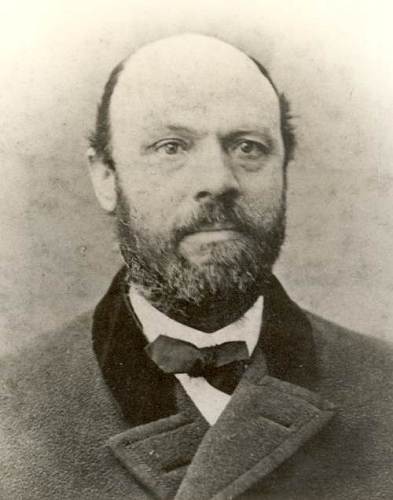
01 Wm. Hauenstein Sr. 1822-1913
George Hauenstein grew up in Tuscumbia and in 1886 married Ida McCommons (photos 02 and 03). They started the Hauenstein's General store in a
structure located by the bank of the Osage River near the site of the original Harrison
brothers' store in Tuscumbia. The times were right for a large general store to be built
in Tuscumbia, especially since the Anchor Milling Company's several steamboats could bring
in all the supplies that a general store would need for resale. The roads in those days
were poor or nonexistent and the railroad system was not yet developed completely so the
only way goods for commerce of any quantity could be brought into the Ozarks necessarily
would have to have been by water.
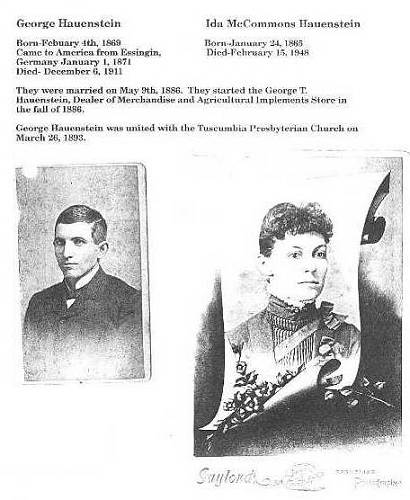
02 George and Ida Hauenstein
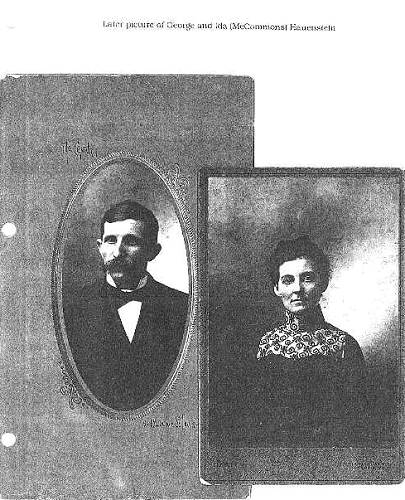
03 George and Ida Hauenstein; Older
The following obituary of George T. Hauenstein is interesting and summarizes well his
biography:
Miller Co. Autogram
December 14, 1911
GEORGE THEODORE HAUENSTEIN
Born at Exsinger, Germany, February 4, 1859. His
father and mother having died when he was only a small child, he with his sister came to
America, January, 1871, to make his home with William. H. Hauenstein, Sr., an uncle who
had preceded them to this country. His boyhood days were spent in and near Tuscumbia. He
received his education in the public schools of this county and also took a business
course at the Valparaiso University, Valparaiso, Indiana.
Mr. Hauenstein was married May 9, 1886 to Miss
Ida McCommons, being survived by her.
In the fall of the year 1886, he became
interested in the mercantile business on a small scale, but his trade rapidly increased,
until at the time of his death his stock was one of the largest in this county. Mr.
Hauenstein had excellent abilities as a business man and had became interested in most of
the important enterprises of this community. Besides his large mercantile establishment,
he owned stock in the Bank of Tuscumbia, the Day and Night Bank of St. Louis, Tuscumbia
Bridge Company, Anchor Milling Co., and other concerns, he also owned several tracts of
land in the county. He carried $5,000 insurance at the time of his death.
Mr. Hauenstein united with the Presbyterian
church here in 1893 and always gave liberally for the support of the church as well as
giving encouragement by his attendance at church and Sunday School.
About a year ago Mr. Hauenstien, becoming aware
that he had stomach trouble of a serious nature, went to St. Louis, where an examination
by physicians of that city showed that he had cancer of the stomach in an advanced stage
and he decided to have an operation performed which was undergone Nov. 10, 1910. He
returned after this and for some time was able to look after business affairs, but two or
three months ago he became confined to his room and death followed December 5th, 1911
Funeral services were conducted by Rev. Bell of
Crocker Thursday morning, Dec. 7th, at the Presbyterian church, after which interment was
made at the Tuscumbia cemetery.
Deceased leaves a widow, a brother, Louis
Hauenstein, of Cincinnati, Ohio, and a sister, Mrs. Mary Nichols of this place, as well as
numerous other relatives.
The following obituary of Ida (McCommons) Hauenstein (photo 04) also is instructive, especially about the later
years of the large general store in Tuscumbia. The obituary pages are in the Adobe PDF
format. You will need the free Adobe Reader program to view them. You can
download the free Reader HERE. You may have to magnify it to read it (photos 05 and 06).
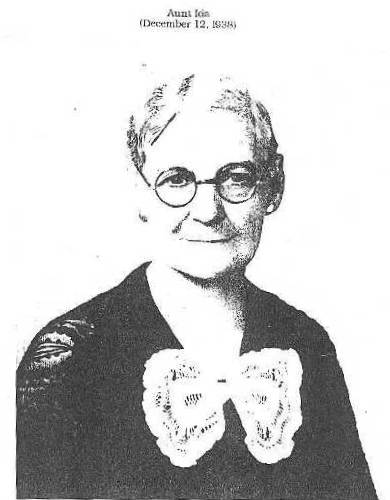
04 Aunt Ida
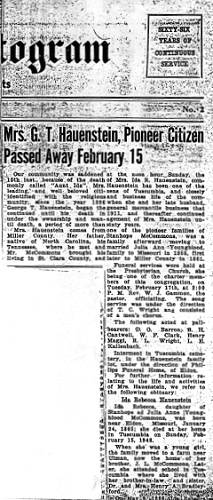
05 Aunt Ida Obit
Click image to open PDF file
|

06 Aunt Ida Obit
Click image to open PDF file
|
I am grateful to Marilyn (Barrons) Bosso for much of the information about Hauenstein's
General Store. She spent quite a bit of her childhood life in the store since Ida
Hauenstein was an aunt of her mother Ruth McCommons Barrons. The following is her account
of the history of the store after Ida Hauenstein passed away in 1948:
"Joe, It just so happens that I was working to update some of
my family history. Aunt Ida passed away on Feb 19th, 1948. Dewey and Ina (McCommons)
Kallenbach (Ina was Aunt Ida's niece) and Dewey's brother, Leonard, all of whom who
previously had worked for several years in the store, continued to work until the
Hauenstein estate was settled in1948. My father and mother (who was a niece of Aunt Ida),
Dorsey and Ruth (McCommons) Barrons, operated the store for the next several years. In
1961 a man named Bud Ward came to operate the store for my mother with the understanding
that he would purchase the store. However, he became ill and was forced to retire because
of ill health. The store eventually was closed in 1964 at which time the property was sold
to LeRoy Snodgrass, a local attorney. Sometime after that it was torn down."
Marilyn has written a short narrative of her memories of the old Hauenstein's Store.
She had opportunity to spend a good part of her youth there since Ida (McCommons)
Hauenstein was her mother's aunt and, as noted above, her parents eventually assumed
ownership of the store after Mrs Hauenstein passed away. This is a scanned document so you
will need to click on the photo of it to read it (photo
07).
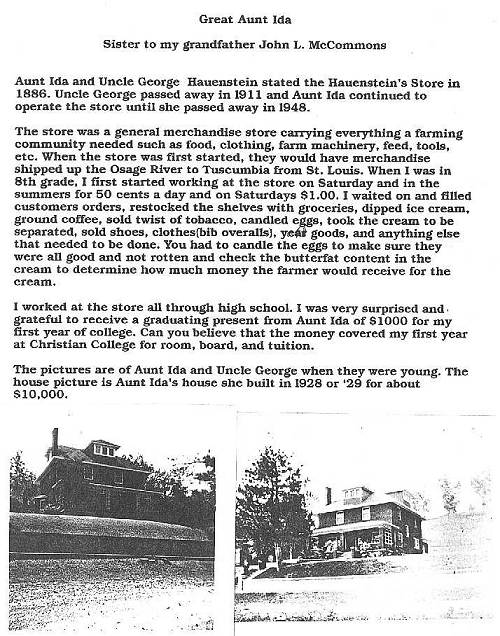
07 Hauenstein Home
Click image to view larger version
Marilyn included in her narrative a photocopy of George and Ida Hauenstein's House. The
house, as noted by Marilyn was built in the late 1920's. It is still standing at the
western end of Goosebottom Street so I took a photo of it as it appears today (photos 08 and 09).
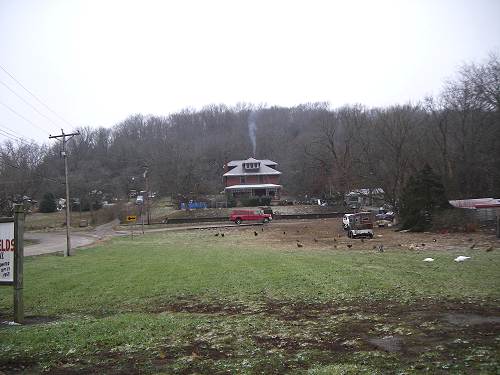
08 George and Ida Hauenstein Home
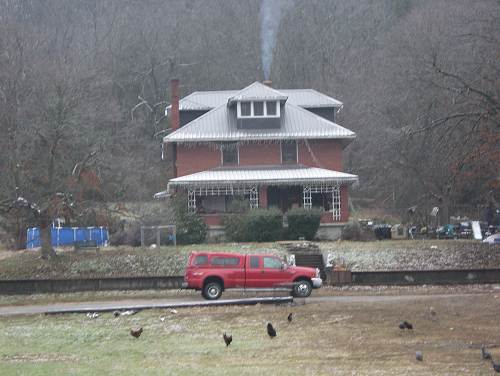
09 George and Ida Hauenstein Home Close Up
The following photos of Hauenstein's General Store taken at different times in the
store's existence include first a photocopy from an old newspaper from the past sent me by
Marilyn Bosso (photo 10). It was taken
soon after the store opened in 1886 and demonstrates that the store had no façade
extending upward whereas the next one taken later shows the addition of an elevated
façade (photo 11). This photo was
sent me by Michael Wieneman, originally of Eldon, Missouri, who has deep roots in Miller
County. Also in the first photo a good view of the large storage shed between the store
and the river is seen.
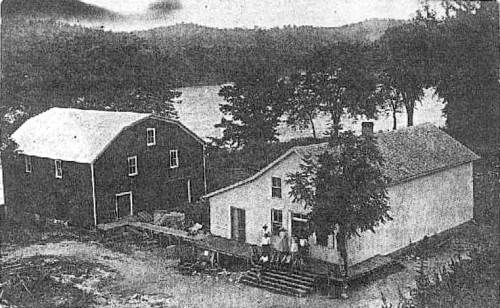
10 Hauenstein Store With Shed
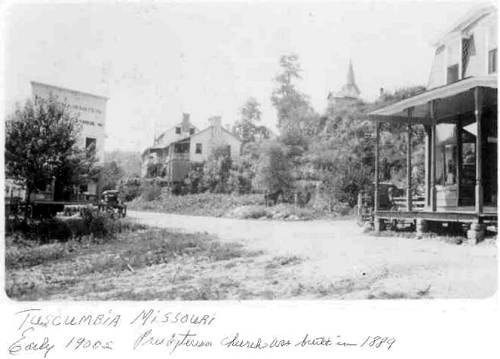
11 Hauenstein Store; Early 1900's
The next photo also sent by Michael (photo 12)
was a street scene also taken earlier before a façade was present. You will notice the
large store behind the man in the street which is the old Fendorf store. It was a general
store also but without the diversity or quantity of products as Hauenstein's store.
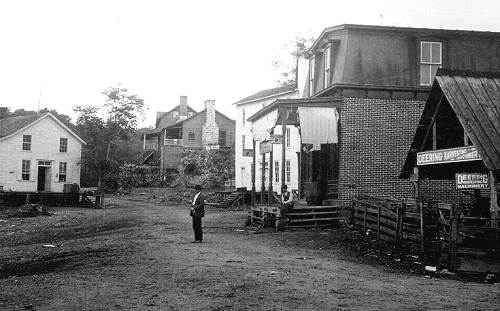
12 Main Street Tuscumbia; Late 1800's
Another photo sent by Michael also very old is from an old tintype (photo 13). It is thought the photographer was standing on the
west side of the building because the slanting roof is on the river side of the building.
Or, alternatively, perhaps this photo was taken from a reversed negative because the steps
and porch seem identical to those noted in the other photos.
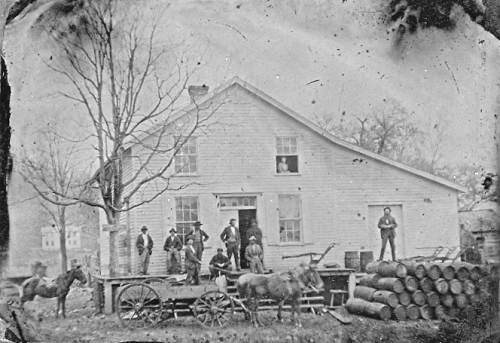
13 Hauenstein Store; 1880's Old Tintype
One of the most descriptive memories of Hauenstein's General Store was written by Doris
(Wright) Clemens (photo 14). It is a
long narrative, taken from her book, "Life…A Trail Of Memories", from which
I quoted last week regarding her memory of Dr. Kouns. I have transcribed it all because it
so accurately reflects the atmosphere surrounding these old country general stores, and
especially that of Hauenstein's.
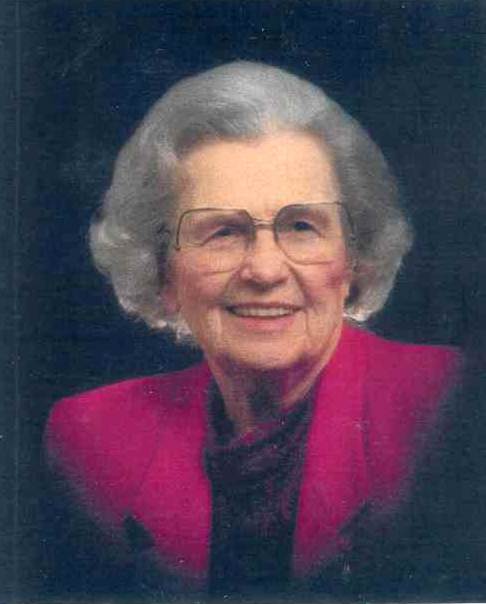
14 Doris Wright Clemens
Doris was the daughter of Lawrence Wright who was the publisher of the Autogram for
many years. The family lived in a large stone house near the school on the hill. However,
Doris and her sister and friends would race down the more than one hundred steps from the
courthouse to the bottom of the hill where Hauenstein's was located quite often because it
was a busy, fun place to socialize and meet people, especially on Saturdays of each week:
Aunt Ida's Great Store
Ida Hauenstein was not my aunt. When I was growing up all older
people were called "aunt" or "uncle" as titles of respect. Aunt Ida
had inherited the General Store from her husband George. But we always called it Aunt
Ida's Store. It was built when Tuscumbia was founded and George, with his brothers Phil
and Bill, settled on the Osage River. Phil was a miller and Bill operated steamboats on
the river. Aunt Ida's niece and her husband, Ina and Dewey Kallenbach, helped her run the
store when I was growing up. When I say it was a general store that is literally true.
From drugs and medicines to yard goods, groceries, farm machinery and everything in
between, she carried it. Every weekday morning at daybreak you could see Aunt Ida with her
big market basket on her arm coming across the little bridge from her home in Goose
Bottom. The bridge was over the slough (backwaters) that drained that part of town. It ran
through the town park on one side and Aunt Ida's back lot on the other before emptying
into the river. As she approached the store Aunt Ida passed the town pump with a long
concrete watering trough for horses. She entered the store through the back door. This
entrance was at ground level, but the front double doors opened off a high porch after one
ascended a flight of ten long wide steps.
The store was a big white frame building that sat on the front
side of a beautifully manicured bluegrass lawn. The building always looked freshly painted
and the lawn freshly mowed. A wide concrete walkway supported by tall square concrete
pillars led from the high front porch to a large barn- like warehouse on the river bank.
The warehouse also sat on high pier pillars to protect if from the frequent floods. Here
steamboats unloaded their cargoes of household goods, hardware, machinery, furniture and
dry goods they had brought up the river from St. Louis or even New Orleans. Everything to
sell in the store except fresh foods. Produce like meat and vegetables could be supplied
locally, daily. All other merchandise came by boat or rail to Eldon and then by truck on
down to Tuscumbia. The main street curved around the building on one side and on down
through the town. An access road to the river from the main street passed in front and
along the pier to the river. Here in early days cattle were driven to the river to be
loaded on the boats and taken up or down stream to sell. Between this road and the pier
was the hitch rail where the farmers tethered their horses for the day on Saturdays.
The store itself was divided into two rooms, the larger section
being the main part. On each side along the walls was a row of shelves with counters in
front. The counters ran front to back of the store on either side of the big room. The
clerk stood behind the counter as you told him the items you wanted. He got them off the
shelves or sacked, weighed, measured and packaged items not on display or shown in bulk.
The customer did not wait on himself. The back door which we always used was on ground
level and closest to the long flight of concrete steps down the hill (we lived on the
hill). Entering the door, we passed double stairs from the middle back of the room going
up to the balconies. These balconies ran all around the store over head. Here was kept on
display a limited amount of furniture. Half way up, the stairs parted from a landing, some
going to one side of the balcony and the others to the other side.
On the wall side of the stairs as we entered was a long built in
desk attached to the wall. Sitting on a high stool at the desk much like Bob Crachett
pouring over the books usually was the bookkeeper, Leonard Kallenbach, a brother of
Dewey's. On the opposite of the stairs was the dress shoe section-shelves for the boxes of
shoes and chairs for sitting in to try on. A monstrous pot-bellied stove stood just in
front of the stairs. In the winter, benches were stationed on each side of the stove.
These were for the convenience of both customers and town loafers. On the left, past the
bookkeeper's desk, was the dry goods section. On the shelves were bolts of cloth. To the
front was all the finer expensive dress fabrics. To the back cheaper cotton dress
materials were stocked with ginghams, percales, cotton flannel, muslins, ticking, linens,
oilcloth, etc. Underneath the front shelves were long drawers filled with bolts of silks,
satins, taffetas, and velveteen dress materials wrapped in tissue to protect them from
fading in the air and sunlight. Stacks of large cardboard boxes nestled on the floor under
the back shelves. These held folded wearing clothes and linens. Lingerie,
"long-johns," blouses, skirts, aprons, everyday dresses, socks, gloves and some
of the sheets, pillowcases and table cloths were stored here. No clothing was out on
display. An isle was left between the ends of the front and back counters so clerks would
not have to go all around the end to get behind and wait on customers. There were ribbon,
thread, button, tape, lace and braid cases sitting on the ledge in front of the shelves.
The front counter was all glass-top and sides. Displayed in it was fine jewelry, belts,
gloves, fancy jeweled combs for the hair, feathers, jeweled hair pins, and artificial
flower boutonnieres-an array of fashion accessories for the lady of the house. Aunt Ida
made an annual buying trip to St. Louis to shop for this merchandise at the wholesale
houses there. The grocery and drug store sections were on the opposite side of the big
room. With the same arrangement of counters and shelves, the medicines and candy were to
the front, the groceries to the back. Sloan's liniment, Scott's Emulsion, Aunt Lydia
Pinkham's compound for women, Peruna tonic for iron in the blood and Cod Liver oil bottles
were some of the home remedies stocked. Cough syrups and Quinine and Bromo Seltzer tablets
carne in handy for colds. Then there were Listerine and Colgate toothpaste for hygienic
purposes. The glass enclosed candy case tempted the sweet tooth of many a child with lemon
drops, chocolate cremes, gum drops, toasted marshmallows, jelly beans, caramels (in
wrappers) and peppermint, horehound, licorice and peanut butter filled sticks. Chocolate
covered peanut clusters were my favorite. Aunt Ida always gave each farmer's wife that
came in on Saturday to shop a sack of candy. She often just stuck it in the comer of the
cardboard box that held the packages, buckets and sacks of groceries. To many a farmer's
wife and her children that was a real treat to look forward to. Underneath the counter in
the grocery isle were large bins that could be pulled out and tilted down. They held dried
beans, rice, coffee, popcorn and other similar bulk items that were scooped out with large
aluminum scoops into brown. Kraft paper bags to be weighed on the scales. The flap of the
bag was folded over and the sack tied round and round with white cotton string. A huge
ball of the string was suspended over the counter near the scales from a miniature round
iron cage. The end always hung down ready to start on the next sack. Items like lard,
peanut butter, hominy, pickles, oysters(only at Thanksgiving), anything moist, was scooped
out of large metal drums or wooden barrels with wooden ladles into waxed pasteboard carton
boats. After a square of wax paper was placed on top, it was appropriately wrapped in
heavy greased paper. This paper was used also to wrap fresh meats. The large roller for
the greased paper was securely attached at the end of the counter with large bolts. But
meats were only sold fresh as soon as they were butchered and brought in from the farm.
Quarters of beef and whole hogs hung on great hooks in the back room to be cut and sold.
Cured meats hung on other hooks down from the ceiling in the back or down in the
warehouse. It was not unusual for a big slab of cured bacon along with a wooden box of
smoked and dried "Fin-and haddie" fish to be on the end of the counter. Fish was
shipped in wooden pails of brine, too. Daddy often bought the whole pail. Chickens were
kept live in cages in a big pen down on the river bank by the warehouse and were sold on
foot. Eggs had to be handled very carefully as protective cartons had not yet been
manufactured. As they were counted out they were put in a paper sack usually only one
dozen to a sack.
Huge wooden barrels sitting in every available space held apples,
potatoes, onions and even crackers in bulk. Lemons, oranges, cabbage, etc., were shipped
and displayed in crates. Fresh vegetables were at a premium. The first crate of fresh head
lettuce in cracked ice was shipped in when my Mother's doctor ordered that she have it.
Daddy bought it and had it shipped by rail from Kansas City. Albro Stepp, the mailman from
Eldon, brought it to Tuscumbia in his Model T. We had to agree to take the whole case, so
we sold some to neighbors. It became so popular the grocers began to stock it. Soon it was
a staple in winter. Flour and sugar sold in cloth sacks-twenty-five pounds of flour and
ten pounds of sugar to the bag. Cornmeal came in heavy twenty-five pound paper bags. Lard
could be bought by the "stand"-twenty-five or fifty pounds in large tin
canisters. Dried beans, both navy and pinto, rice and potatoes could be bought in hundred
pound burlap bags. Vinegar was stored in a wooden barrel with spigot in the back room.
Each customer always brought his own vinegar jug to have it filled. The same was true of
kerosene and each had his own kerosene can. Butter, along with the eggs and chickens, was
bought fresh from the farm wife. A pound round of it was put into a "boat" first
covered with wax paper before the greased wrapping paper. Sorghum and syrups came in
gallon and half gallon tin cans and buckets. The shelves in the grocery section held all
canned fruits and vegetables much as they appear today. Boxed items such as salt and
pepper, soda, baking powder, Argo starch, corn starch, coconut and Quaker oats stood here.
Bottled items like bluing, mustard and later catsup also were placed on these shelves.
Bread was held on wire racks supplied by the bakery. The bakery supplied only the one
brand of bread and it was white. Daddy, being the health "nut" that he was,
introduced the town's people to whole wheat bread. The grocer special ordered him a loaf
or two at a time. Soon others wanted to try it so the grocer started getting more. It soon
became a staple like the lettuce. The grocer carried only one brand in everything he sold.
So the housewife was never in a dilemma over what brand was best. And pre-prepared foods
were unheard of. The back room out the door from the grocery section was a long narrow
room with counters down the center. It always smelled of leather, rubber, fertilizer and
feeds. Bridles and other harness hung from the walls. Later automobile tires were stacked
in this room. Blocks of salt for the farmer's cattle were stocked along with the dry feed
and fertilizers he needed. Small machinery, farm hardware and tools were kept here. Nails,
screws and bolts stood in wooden kegs and were sold from the bulk by the pound. They were
weighed up in heavy brown paper bags. Cans of varnish and linseed oil were stacked on the
shelves with the buckets of paint. Paint brushes, hammers, pliers and other small tools
were suspended from wall hangers. Larger tools and machinery such as plows, harrows,
wheelbarrows, rakes, shovels, picks, axes, etc., were stored in the warehouse. Some of the
farmer's work clothes such as heavy plow shoes, overshoes, gum boots, caps, heavy work
socks, gloves, shirts, pants and jackets were displayed on the counters. A crank phone
hung on the back wall and was in use quite frequently. Aunt Ida's was a busy place. Cane
bottomed straight chairs were placed in convenient spots all around the main floor. These
were for the convenience of customers, especially on Saturdays. Saturday was a visiting
day, the day all farmers came to town. Not only to bring their farm products but to buy
"store-bought" staples like sugar and coffee. They were accompanied by their
wives and children. The most important thing for the ladies and men both was to catch up
on the local news and gossip. While the men went to the bank, conducted business at the
courthouse, went to the printing office to pay their subscription or any of the other town
chores, the ladies sat and visited and the children ran and played outside.
Dan Welshons was a handyman and liked to visit with and tease the
children. Dan did all the dirty chores like feeding the stove with wood, sweeping floors,
toting freight, and helping unload or load wagons. He lived in a shanty in the woods just
outside the Possum Trot neighborhood. It was covered with sheets of galvanized roofing for
siding. It was only one tiny room but since he spent most of his time at the store, it was
sufficient. The story was told of a Mr. Helstab who forgot and left his wife in town one
Saturday. Seems after they had gone to town, he spent the day on various errands and late
in the afternoon hitched up the team, loaded the groceries in the wagon and left up the
river road for home. Upon arrival he realized his wife was still in town. He returned for
her!
Mrs. Small always walked to town to shop for dress materials. She
walked from their log house on the Eldon road outside Tuscumbia because they had neither
horses or wagon or buggy to bring them the three miles. Her husband always worked in
Kansas City and seldom came home. Mrs. Small had five daughters so had a lot of dresses to
make. Each girl took her turn for a new dress and their mother always brought that one to
town on Saturday with her to select the material. Then she actually measured the cloth to
her daughter's body. If she had a pattern she laid that out on the material on the
counter. She spent the afternoon figuring to be sure she didn't buy an inch more than was
necessary.
The Jackson family came from their farm across the river near the
small town of Ulman about fifteen miles away. They were sure customers before the day was
over. Their old maid daughter Julia drove their big Hudson like a chauffeur. The mother
and father rode in the back seat. They always went through town early on Saturday morning
on their way to Eldon to shop for dry goods. In early afternoon they came back to shop at
Aunt Ida's for groceries on their way home. They were wealthy-the only farmers in the area
to own an automobile. Mr. Jackson had made his money buying and selling cattle. Like a
true cattleman he always wore his black Stetson hat. The mother and daughter were always
dressed in the height of fashion. As a young teenager I admired Julia's attire and her
social graces and demeanor. She entered the front door of the store with her kid gloves
(driving gloves) and fancy hat on. A tall slender lady of noble carriage and stature, she
made quite an impression on me. An attorney, Jack Stanton, was a close friend of Julia
Jackson's. Originally of Miller County stock, he lived most of his life in Kansas City.
Upon retirement he built a law office in Tuscumbia and practiced. Julia's parents were
dead, but she still lived on the farm near Ulman. Before Jack died he had a large, oblong
monument erected possibly ten or twelve feet tall in the country cemetery near Ulman. On
it, his lifetime history was engraved. He was a man of great personality as well as size
and his tombstone is equally imposing.
(Note: Actually, Jackson C. Stanton's burial was in Freedom Cemetery near Linn Creek.
His tombstone there definitely was impressive (photo
15). I wrote a narrative about Jackson which you can find in the archives
listed at the bottom of this page: http://www.millercountymuseum.org/071126.html)
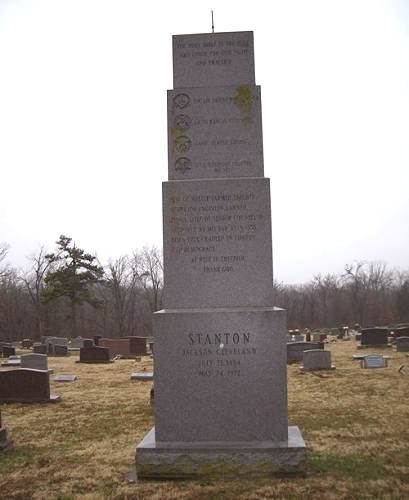
15 Jackson C. Stanton Tombstone; Freedom Cemetery; Camden County
The Flaughers were regulars, Bertha and Charley. They were farm
folks from up the river. They had a little boy about five years old whose name was Junior.
Junior had taken the bottle when he was a baby and couldn't give it up. At the age of five
he still brought his bottle of milk (with nipple) to town...in the hip pocket of his bib
overalls. He sure looked strange out playing with other little boys with his bottle in his
pocket, but it never embarrassed him to get it, out and "pull" a drink when he
got thirsty. These people were all very unique and entertaining to me and my sister,
Dorothy. Sadie McCommans was another "fixture" in the store. She was an old maid
from Ulman, the sister of lna, and clerked in the dry goods section for years. Leonard and
Dewey took care of the grocery and hardware sections, and Aunt Ida would "wait"
on anyone, for anything, anytime, to make a nickel. But she was generous to a fault to the
poor, especially at Christmas. We considered Sadie a buddy. Even though she was quite a
few years older than we, she got lonesome staying in the store all day, and always enjoyed
our visits. She knew all the gossip, the juicy bits of news which she shared with us. She
liked to tease us about our "boy friends," too. So after school visits and
Saturday afternoon hours we whiled away were a part of our country "fun." As
soon as the house was swept, scrubbed, polished and shined, Dorothy and I took our weekend
baths and dashed to Aunt Ida's on Saturday to spend the rest of the day.
On one warm, breezy spring afternoon when Dorothy and I burst in
the front door from school Mother questioned, "Would you two girls like to go down to
Aunt Ida's and pick out a new spring coat?" Oh! of course! The city salesman was in
town for the day. It would be the first spring coat either had ever owned. We were
delighted and scampered down the hundred and fifty steps to town at breakneck speed.
Bounding in the back door, we dashed up the stairs to the balcony. That was where the
salesman would have set up his racks of merchandise. We started sorting through the
displays picking out and trying on-admiring ourselves in the long mirror-trying on coat
after coat. We had so much fun trying on and parading up and down the long balcony, each
critiquing the other. Finally, we each had our favorite. Dorothy's was a light-weight
camel tan flannel with an overall cape hanging to the waist. As usual I went for one more
suitable for an older person, more reserved yet more unusual. Mine was black rayon faille
with inch wide, lengthwise satin strips through it. It only had a half cape-fin shaped, it
was stitched to the coat down the center back coming to a point at hip length. It fell
over my left arm and shoulder only. Both coats were straight, no belts; and the sleeves in
both were straight and plain. The salesman also had dresses and, my coat having cost less
than Dorothy's, I got a new dress, too. I was a junior in high school, Dorothy a senior. I
wanted the dress for Sunday night baccalaureate church services. Juniors always served as
ushers for the seniors as they marched in. My dress was of soft rayon taffeta. It had tiny
pin dots of white on a dark navy background. The waist was basque fitting and was buttoned
down the back with tiny self-covered buttons. The sleeves were short, tiny full gathered
puff sleeves bound with an edging of the same material. The neck was finished with a
frilled ruffle of three layers of white and pastel pink and blue sheer crep-de-Chine or
georgette. The skirt fell princess style from the tight waist in deep folds with many
gores. I was so slender, young and girlish, yet a young lady. It became my favorite
"sparking" dress and the next summer after graduation I was married in it. Aunt
Ida's store is no more. It was torn down many years ago after Aunt Ida died and it passed
through several hands. The natives all bought cars and most started going to the chain
stores in Eldon to shop for cheaper groceries. The lot is now used by the State Highway
Department and is piled high with gravel for road maintenance. The boat landing with
access road and river bank is still kept beautifully seeded with blue grass and mowed by
the Corps of Engineers. It is still a very pretty setting where visiting tourists can
launch their boats in the Osage River on fishing expeditions. Tuscumbia, with a fifty
percent loss in population, still supports one grocery store only. It is up on the hill
(Note: since this was written no complete line grocery store exists in Tuscumbia). Aunt
Ida's only competition in general store trade was Uncle Frank Fendorfs store across the
street. Uncle Frank was a brother of my Grandma Wright and after he died, and I was an
adult, his store burned. So time marches on. .
Thanks Doris.
My own memories of Hauenstein's Store are similar to those above narrated above.
Several memories, however, stand out above the others in my mind. One of these revolves
around the characters of Charles "Catfish" Williams and his brother, Willard
"Friday" Williams. Catfish always wore an English style cap with short brim,
sometimes called a "driver's hat" (photo
16).
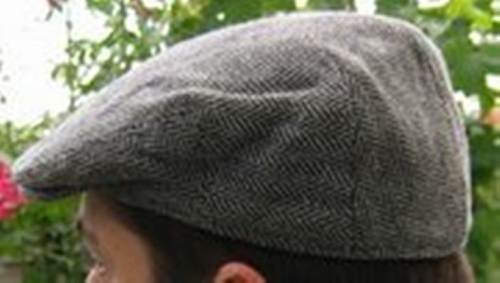
16 Driver's Hat
I never saw him in overalls like many of the men wore then, but always in tan colored
pants and shirt. He had a tendency to drink too much and always had a cackling type laugh
which would burst out at not particularly relevant times. He was not permanently employed
but helped with tasks around the store. Sometimes he was a chauffer for Dr. Kouns, but
that was before I was born. It was said he got his name due to an accident which occurred
while fishing when he cought a big catfish and on yanking on the fishing pole the hook
came out of the fish's mouth and poked through his lip in such a way that Dr. Kouns
couldn't get it out without a lot of holding Cat down as well as dealing with a lot of
profanity. It didn't seem to cause any significant resentment on Cat's part toward the
Doctor because he continued to be his driver for house calls. Friday could be found every
day sitting along side the old cement watering trough which before my time was used to
water the horses and teams that came to town. Friday always wore overalls, a stained
leather Stetson, smoked cigarettes which he rolled, and had a bad eye which was scarred,
red, and was turned upward. He also did some small chores for the store. I haven't found
anyone who knows how Friday got his name. Some of the readers of this narrative may be old
enough to remember these brothers. I hope so because the mystery of their family of origin
and from where in town or the county they came is unanswered. In all the time they were
around town, no one ever seemed to ask or inquire, and now that they are gone, it has been
an impossible task, it seems, for me to know more about them than just they were perennial
fixtures associated with the store which made an impression on a young boy's mind.
When I was a young boy, the store still retained most of the features described by
Doris above. I had a saddle horse from about the age of ten which I used a bit on the farm
mostly to ride the fence line to find where the cows were getting out (and where Jim
Harrison's bull was getting in). Elmer Flaugher was still blacksmithing then as well as
serving as the local ferrier. He always sent me to Hauenstein's to get the shoes for my
horse when it needed shoeing. I remember the bins of shoes and square horse shoe nails
stored in the west section of the store where farm tools and equipment could be found as
well as a lot of horse tack. Elmer usually didn't need me to buy any "toes" for
the shoes; however, by the time I came along times had changed and some of the roads had
been paved in town causing my horse to slip and slide as I was riding it to the saddle
club arena in the ball park. So I remember one time he had me get some toes from the store
which he forged at the front of the shoe and he heated the shoe horns at the rear to bend
up some "caulks," all to give the hooves some traction on the pavement. Elmer
was a man of many talents. Besides being the town blacksmith for many years he also was
well known for the "John Boats" he constructed as well as having been a
"tie whacker" and fiddle maker (photos 17
and 18).
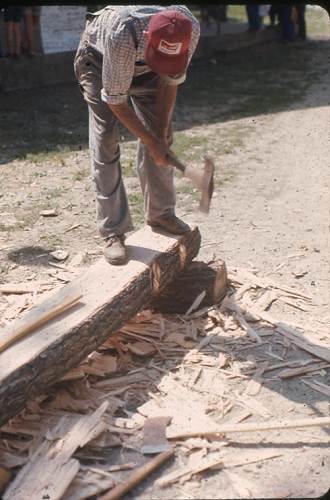
17 Elmer Flaugher; Cutting Ties
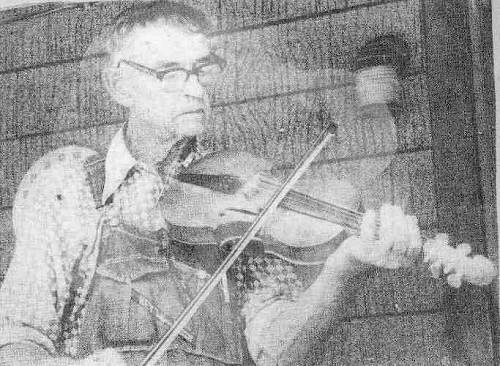
18 Elmer Flaugher
One very happy memory I have of Hauenstein's Store were the "ice cream cones"
which sold for a nickel and were always vanilla flavored.
Another thing I remember when I was in high school (when Bud Ward owned the store); I
was wondering around the up stairs and found some old cardboard boxes stored away under a
large shelf which contained about fifty or more old English styled caps (photo 16 above), the type to which I
referred above which Catfish Williams wore. I doubt they were special ordered for Cat
Williams. Bud knew nothing about them. They must have been stored away for a long time
back there under those shelves. I know that in the 1800's you could find photos of men
around the area who wore this style cap so I imagine they had been bought long ago for
resale at a time when some men wore them. At any rate I asked Bud if I could buy one and
for how much. He couldn't decide right away so I offered twenty five cents each if I
bought ten of them. He readily agreed and I took them away and sold some of them to some
of the kids at school for fifty cents each. I don't know now where they all went to
including mine. Bamber Wright may have bought some in the past since he can be seen even
now sporting this style cap once in a while. Another time I was meandering around inside
the old large storage shed between the store and the river and found an antique popcorn
machine. Again, no one knew its origin; I suspect it was used at the Annual Homecoming
Picnic at the Riverside Park located just across the Shut In Branch west of the store. I
bought the popcorn machine from Bud for twenty five dollars and later sold it for forty
dollars after I got married and had no place to store it. The old store had lots of
memories for everyone who went there and I just wonder what interesting treasures were
left like the ones I discovered when it was torn down years ago.
Finally, my mother spent all her youth along the river in Tuscumbia since her parents
owned a store just down the street from Hauenstein's Store. I asked her to email me some
of her memories:
Joe told me he was writing about Hauenstein's Store and has asked
me to send him all of my remembrances. I will send all that I can think of but they won't
be in sequences since I have to wait on my mind to respond & then I will immediately
write it down. First is the loafing place right at the back of their store where their
well was located. It had a concrete slab covering it which afforded plenty of sitting
room. People that had nothing else to do liked to sit there & watch what went on
because it was located facing main street. Would you believe romances developed there with
complete strangers to start with?
There were a few of the same people there every day. For instance,
there were Catfish & Friday Williams who were brothers. Jack Hawken is another one
that comes to mind. Tuscumbia is the only place that had a high school in this area &
if folks wanted to further their education there were a couple of buses that brought them
in from St. Elizabeth & Iberia Mo. These people explored the town during the noon
hour. They found it interesting to talk with whomever was at the Well. It seems that this
one pretty girl from St. Elizabeth found Jack Hawken very appealing. They met every day
& there developed a serious romance. So much so that they defied tradition &
eloped together & nobody knew where to find them. Margaret never confided with her
folks & Jack had no folks to confide in. That all created quite a buzz. As time passed
the curiosity ebbed & at the same time Jack got hungry to see his friends at the Well,
his favorite Loafing Place so they came back to Tuscumbia & moved into a two-room
cabin that my Mom had in the back of our house in Goosebottom. It must have been a
bonified storybook romance for they stayed married until years later when Jack passed
away. Two strangers met at the Loafing Place & made a go of it, Margaret Holtmeyer
& Jack Hawken and that's what I meant when I said romances began at the Well.
Another memory I found a little startling to me, a child. The
Tuscumbia annual picnic was in high gear & a small crowd began to gather around the
porch on Hauensteins Store. There was a man lying there that some said was dead &
others thought had imbibed too much liquor & just passed out. Nobody seemed to want to
investigate. To me that was eerie & I left quickly only to find out later he was dead.
I also knew the man & that made it worse.
George & Aunt Ida Hauenstein built the Hauenstein Store &
built it up; then George died leaving the store to Aunt Ida to manage. She was not so
young at this time so she asked her niece, Ina McCommons & her husband Dewey
Kallenbach to help her as well as Leonard Kallenbach, Dewey's brother. It must have been a
fun place to go down to their store in the evening & stay until they closed at night
because I remember so many people who socialized there in the evenings.
One Halloween night the trick or treaters were on the prowl to see
what they could cook up for excitement. They spied a trailer about the size to haul a
pretty good load sitting there in Hauensteins parking lot close to the store. Well, they
decided to turn it over & did. But it was heavy & made a big loud noise & they
all scattered in a hurry. The owner heard the crash & came running; the loud cursing
that he gave when he saw it was louder than the crash of the trailer. I witnessed this
episode from the porch on our store across the street & I also knew him. If you stayed
at the Well late enough on Halloween you could see shadowy forms on the bluff above turn
over a privy or two.
Dewey delivered groceries from the store to those that called the
order in & he usually came every day. Joe was around 4 yrs. old & every morning
Dewey greeted him by saying, "Good Morning, Orange Blossom". That didn't take
too good for that little four year old. So Dewey obliged him & a few days later Dewey
told me about it
The Hauenstein Store kept all kinds of attractions up in their
balcony that kids liked. I still have several different things such as vases, etc. that
Joe & Trish bought me for my birthday. There was a box of men's caps up there that had
long passed their popularity. Joe spied them & thought they were neat for it was the
kind that Catfish Williams, the Loafer always wore. So Joe asked them how much they cost.
I guess that kind of amused them so they told him about a quarter. He bought one & so
proudly wore it to school. The next day the kids all ran down the steps to Hauenstein's
and piled upstairs into the balcony & bought all they had.
There were a few times that poor old Catfish moved out of his spot
at the Well whenever Dr. Kouns asked him to drive him to see a patient for he never
learned how to drive and they say he always kept his foot outside the car on the running
board of the Ford car he owned.
Aunt Ida was sorely missed when she passed away at a good old age.
Leonard decided he wanted to build his own grocery store & Hortense (Swanson), his
wife & her sister, Gardie Swanson, the long time elementary school teacher in
Tuscumbia helped him. This store was built just across from their home on the hill near
the courthouse. The women prepared lunches & Leonard took care of the rest of it. I
guess Ina & Dewey were ready to 'hang their hats up" too so Dorsey & Ruth
Barrons bought Hauensteins Store. Ruth was Ina's sister & Aunt Ida's niece.
Sometime later Ruth sold the store to a couple with the last name
of Ward. I moved to Kansas City shortly after that, so I don't really know the rest of the
history but the last time I looked the Hauenstein Store was no more & most of the
people I've talked about are gone; it is sad to see the empty spot of so much history.
Thanks mom.
You may have noticed in the narratives above that the "steps" leading up the
hill from Hauenstein's Store to the Courthouse location are mentioned. You can read more
about the "steps" on our own website in an article about Tuscumbia written by
Doris (Wright) Clemens' father and uncle, Lawrence and T.C. Wright found at this location:
http://www.millercountymuseum.org/communities/tuscumbia.html
You will have to scroll down the page to near the end of the article where the photos
and narrative about the "steps" can be found.
Last week a number of volunteers at the museum accompanied my wife, Judy, myself and
museum director Nancy Thompson to visit the Moniteau County museum in California, Mo (photo 19).
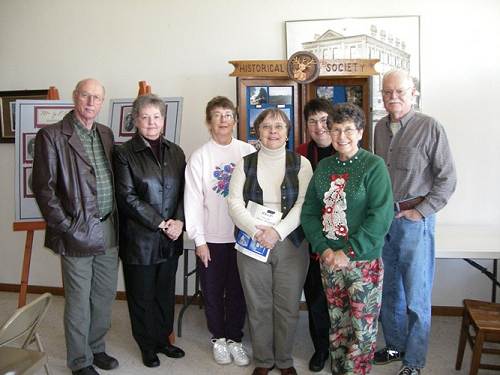
19 Brice and Betty K., Doris W., Nancy T., Judy P., Sharon H., Richard S.
The museum director, Richard Schroeder, is a retired Missouri Conservation agent who
has an intense interest in the history and culture of Missouri, and especially that of
Moniteau County. Richard remembered well a couple of agents in our Miller County with whom
he worked at times, John Dinkens and Richard Robbins (who sadly passed away a few years
ago). Richard Schroeder is a person with artistic and design talents and has worked with
other very talented members of the local historical society to create a museum which is
highly touted and recognized by experts in the field. So we were very appreciative of the
wonderful tour he gave us and the pointers he offered to help us with the redesigning and
restructure of our own Miller County museum's new addition, a project in which we very
busily are working this winter. The museum is located in the old post office (photo 20) and is across the street from the
famous Latham Clinic (photo 21) now
closed.
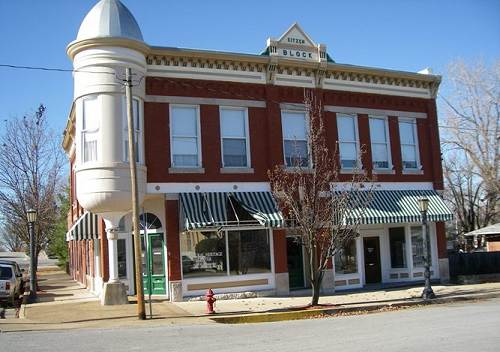
20 Old Post Office
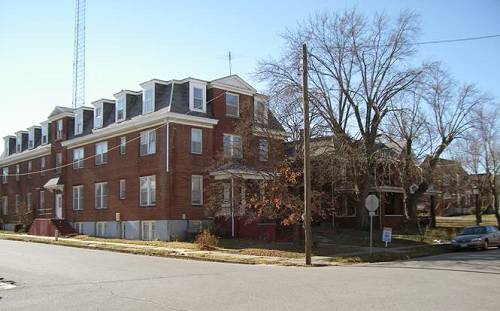
21 Latham Clinic
The Latham Clinic at one time was very famous; patients traveled there to receive
consultations from very far away. My grandfather went there often when he felt he had an
illness that was "too tough" for the local doctors. One of our board members,
Betty Kallenbach, was delivered there. The museum's major unique feature are the many
display cases with glass windows each of which has a historic theme accompanied by photos,
artifacts and artistic drawings which tell a story. Richard has agreed to consult with us
soon on implementing some of his ideas in our new museum addition. Another famous store in
California, now closed, was "Heck's Saddles".
More information is coming in about the Miller County Jail. Cindy Helton, who with her
husband Ron, is rehabilitating the old jail in the courthouse square, reminds me that an
interim jail (used by the county between the time of exiting the one that the Heltons' now
own and the time that the new one on highway 52 was finished just a few years ago) was a
small white cinder block building (photo 22)
on the west side of the courthouse just south of the Miller County Title Company.
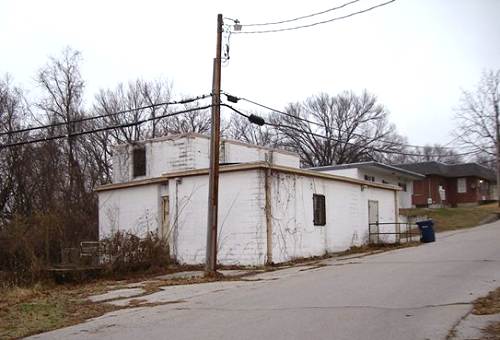
22 County Jail; 1980's and 1990's
The white cinder block building is still owned by the county but utilized for storage.
In 1980 the old vacant jail now owned by the Heltons' was utilized by the Miller County
Historical Society for its museum until 1991 when the museum was moved to its present site
in the old Anchor Milling Company Hardware store on highway 52 near the present courthouse
where the new and the last jail also is located. The Heltons' purchased the old jail and
courthouse from the county a couple of years ago. More information about this interim jail
was given me by Peggy Hake:
"The cinder block building to the west of the old courthouse
was first built as an office (I think someone once told me an attorney had an office
there) and later was used as the jail until the new one was built. In the 1980s the cinder
block building was a VERY crowded jail and there wasn't nearly enough room in it for the
number of prisoners that were held. Some had to be farmed out to other jails in the
region. On the lower level were the cell blocks (dirty, dark, and really forboding!) I had
to visit there on different occasions when I was a commissioner and hated to go to that
area, but usually had someone to escort me through the mess........Sheriffs Gerald Whittle
and Gaylord McDaniel always gave me some assistance and I felt safe with them on
hand.....The building sat next to the Miller County Title Company, owned by Jim Grantham
in the late 1970s and early 80s. I worked for Jim for a couple of years until I ran for
the office of judge/commissioner, That was when I first became acquainted with the
insufficient jail on the cliff side of the courthouse........
Peggy"
Last week on this web page I mentioned some information given me by Ron Helton about
the remains of an old foundation which he believes was an old jail used by the county in
the time between the use of the first one built farther north on High Street across the
street from the Christian Church and the use of the one he now owns in the old Courthouse
square. So a few days ago I went to the south west side of the old courthouse square and
indeed found an old concrete foundation buried in the brush and trees located at the left
side of the top of the stairs (if you are facing down the stairs) which descend the hill
down into the old part of Tuscumbia. The foundation is small, about ten by ten feet
square. Only the concrete floor is present. The foundation under the floor has two small
screened windows, one on the north and one on the south side. Under the steps on the west
side of the foundation an opening has been bricked in. I am uploading photos of what I saw
(photos 23, 24, 25, 26).

23 First Floor
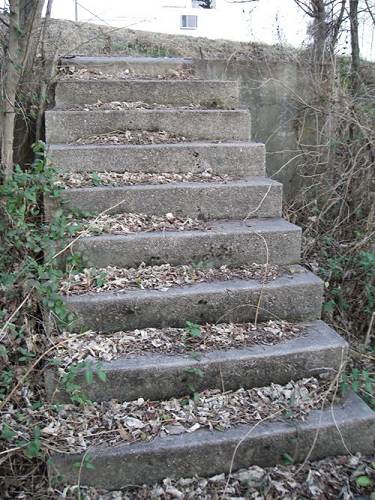
24 Steps Leading to First Floor West Side
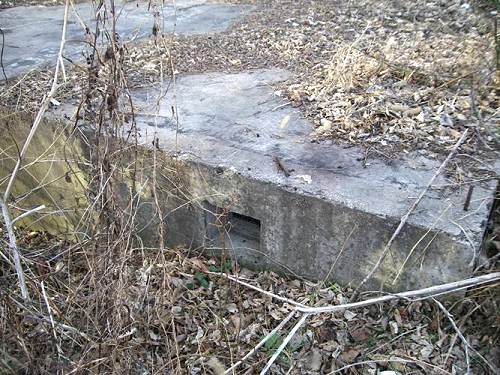
25 Small Screened Window Lower Level South Side
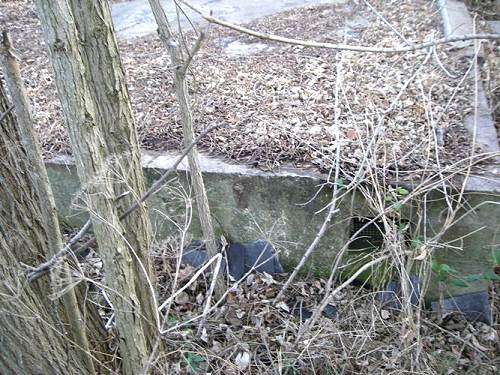
26 Small Screened Window Lower Level North Side
The old Goodspeed history book on page 541 says "In 1865 the present stone jail in
the court yard was ordered built and in 1879 one cell of this was leased to the town as a
calaboose." Ron Helton tells me his research indicates that Missouri law in the
distant past required that any jail had to be within eye sight of the gallows used for
hanging. That is why Ron believes that when the old brick courthouse was built on the
square at the south end of High Street, the old jail first built further north on High
Street across from the Christian Church had to be moved. Ron believes that this old
foundation hidden in the brush is that building; that is, the second Miller County Jail.
I am very thankful to Ron and Cindy Helton for helping me to be more accurate about the
story of the Miller County jails. They have spent hours and hours researching the subject
a great deal of which is from the microfilm archives of the State of Missouri. It is clear
that when they complete their restoration of the old jail and courthouse the historicity
of the old buildings will be preserved.
Our Christmas Potluck Dinner was celebrated last Sunday afternoon (December 9) at the
new museum activity hall on the lower floor of the new addition. Prior to the meeting
Karen Smith, Nancy Thompson and Doris Wiggins were busy preparing enlarged photos and
narratives to hang on the walls to display pictorially the history of early transportation
in the county via steamboats and railroads (photo
27).
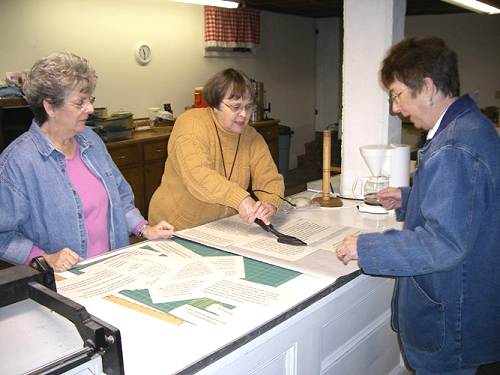
27 Karen Smith, Nancy Thompson, Doris Wiggins
Come Sunday the day of the Christmas Potluck Dinner and the meeting room was
exquisitely decorated and ready (photo 28).
Christmas decorations were placed and waiting (photos 29 and 30).
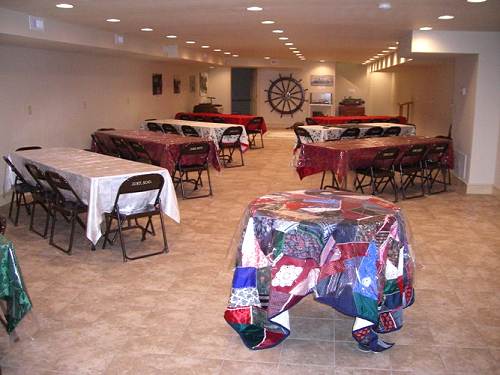
28 Ready For Christmas
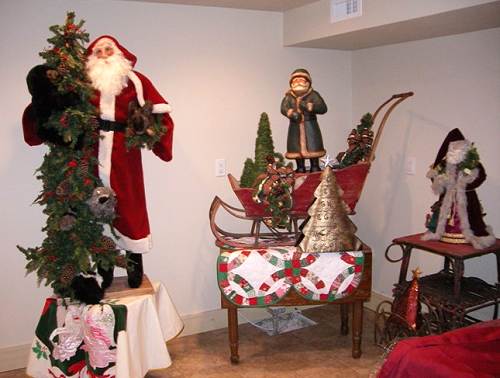
29 Corner Santa
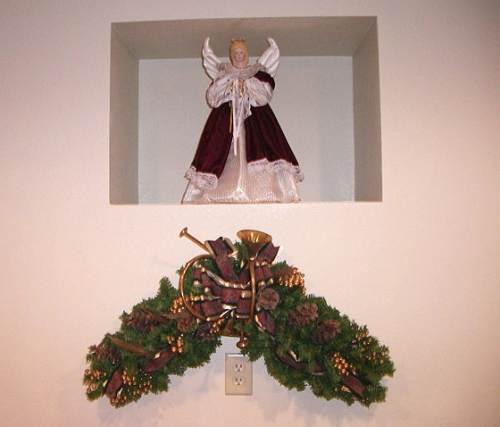
30 Wall Angel
However, we awoke to a terrible ice storm closing roads and causing widespread power
loss. The meeting wasn't cancelled and we had a nice crowd attend (photo 31)…..our two mothers!! Well, actually a few more
braved the storm (photo 32). They were
treated to homemade coconut cream pies by Elva Steen (photo 33) and homemade bread by Janie Davis (photo 34).
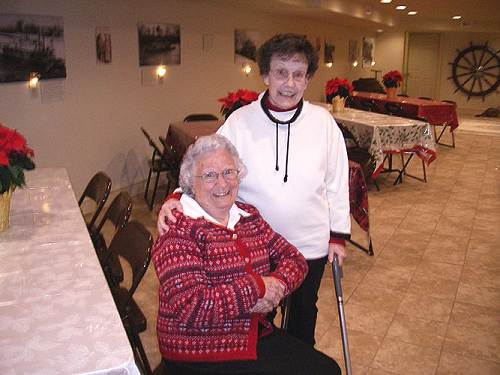
31 Elva Steen and Susie Pryor
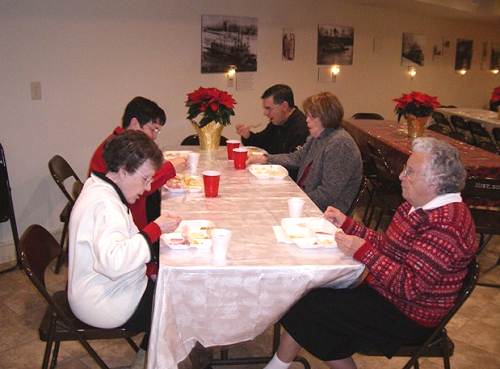
32 Susie Pryor, Judy Pryor, Donald Steen, Alisa Steen, Elva Steen
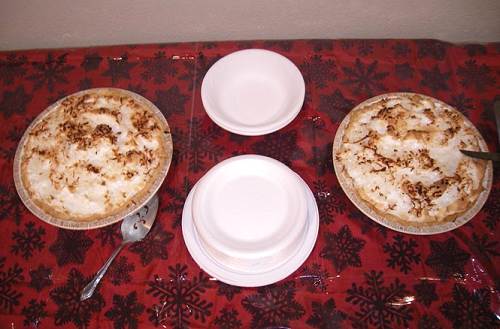
33 Coconut Cream Pies by Elva
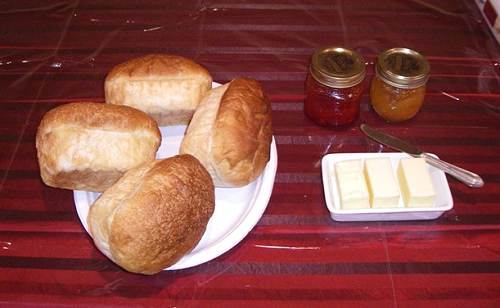
34 Homemade Bread by Janie
And on that note goodbye until next week.
| 


